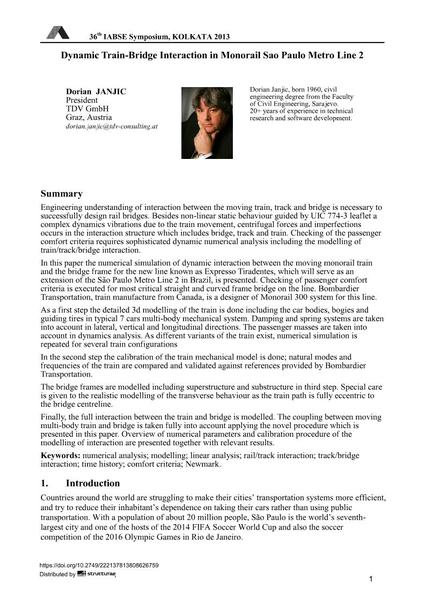Dynamic Train-Bridge Interaction in Monorail Sao Paulo Metro Line 2

|
|
|||||||||||
Bibliographic Details
| Author(s): |
Dorian Janjic
|
||||
|---|---|---|---|---|---|
| Medium: | conference paper | ||||
| Language(s): | English | ||||
| Conference: | IABSE Symposium: Long Span Bridges and Roofs - Development, Design and Implementation, Kolkata, India, 24-27 September 2013 | ||||
| Published in: | IABSE Symposium Kolkata 2013 | ||||
|
|||||
| Page(s): | 1-8 | ||||
| Total no. of pages: | 8 | ||||
| Year: | 2013 | ||||
| DOI: | 10.2749/222137813808626759 | ||||
| Abstract: |
Engineering understanding of interaction between the moving train, track and bridge is necessary to successfully design rail bridges. Besides non-linear static behaviour guided by UIC 774-3 leaflet a complex dynamics vibrations due to the train movement, centrifugal forces and imperfections occurs in the interaction structure which includes bridge, track and train. Checking of the passenger comfort criteria requires sophisticated dynamic numerical analysis including the modelling of train/track/bridge interaction. In this paper the numerical simulation of dynamic interaction between the moving monorail train and the bridge frame for the new line known as Expresso Tiradentes, which will serve as an extension of the São Paulo Metro Line 2 in Brazil, is presented. Checking of passenger comfort criteria is executed for most critical straight and curved frame bridge on the line. Bombardier Transportation, train manufacture from Canada, is a designer of Monorail 300 system for this line. As a first step the detailed 3d modelling of the train is done including the car bodies, bogies and guiding tires in typical 7 cars multi-body mechanical system. Damping and spring systems are taken into account in lateral, vertical and longitudinal directions. The passenger masses are taken into account in dynamics analysis. As different variants of the train exist, numerical simulation is repeated for several train configurations In the second step the calibration of the train mechanical model is done; natural modes and frequencies of the train are compared and validated against references provided by Bombardier Transportation. The bridge frames are modelled including superstructure and substructure in third step. Special care is given to the realistic modelling of the transverse behaviour as the train path is fully eccentric to the bridge centreline. Finally, the full interaction between the train and bridge is modelled. The coupling between moving multi-body train and bridge is taken fully into account applying the novel procedure which is presented in this paper. Overview of numerical parameters and calibration procedure of the modelling of interaction are presented together with relevant results. |
||||
| Keywords: |
modelling comfort criteria numerical analysis Newmark time history linear analysis rail/track interaction track/bridge interaction
|
||||
